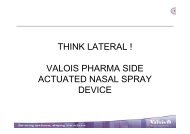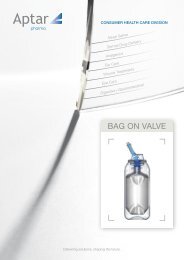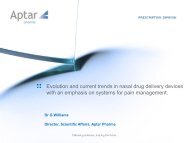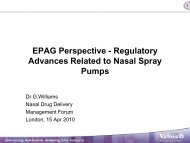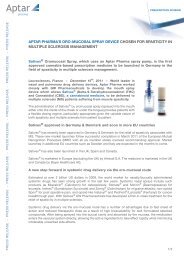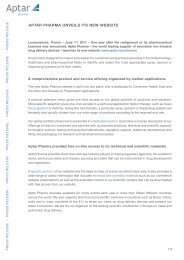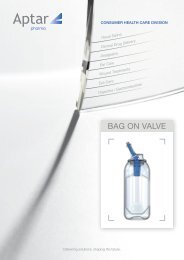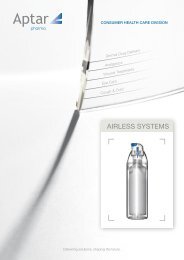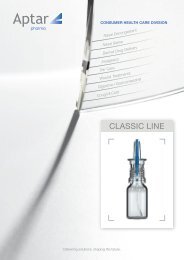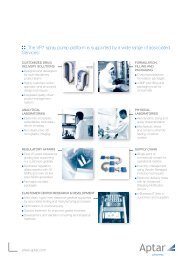Multi-Dose Container for Nasal and Ophthalmic Drugs: A ... - Aptar
Multi-Dose Container for Nasal and Ophthalmic Drugs: A ... - Aptar
Multi-Dose Container for Nasal and Ophthalmic Drugs: A ... - Aptar
You also want an ePaper? Increase the reach of your titles
YUMPU automatically turns print PDFs into web optimized ePapers that Google loves.
522<br />
Drug Development – A Case Study Based Insight into Modern Strategies<br />
devices (Bommer et al., 2004) as well as <strong>for</strong> ophthalmic devices (Marx et al., 2010). For such<br />
device qualification tests most often the devices are filled with broth medium provide<br />
optimum conditions <strong>for</strong> the germs to growth in the case of any contamination. The final<br />
product will promote bacterial growth much less which provides more confidence.<br />
Picture 6. Microbial test to challenge the tip seal function <strong>and</strong> contamination of delivered<br />
doses with a preservative-free ophthalmic dropper.<br />
7. Summary<br />
The intranasal route can be used <strong>for</strong> a wide range of applications <strong>and</strong> administration<br />
procedure is safe <strong>and</strong> easy. On the other side, development of a nasal <strong>for</strong>mulation <strong>and</strong> to<br />
identify the right device is a complex process. Cooperation with an experienced pump<br />
manufacturer <strong>and</strong> specialized test laboratories on the selection of the delivery system <strong>and</strong><br />
setting the right specifications can save resources <strong>and</strong> increase probability of success. Selecting<br />
the wrong spray pump or bottle can jeopardize the entire project so a range of pumps should<br />
be tested early in the development process. In this chapter we have focused on multi-dose<br />
devices <strong>for</strong> liquids because they clearly dominate the market. In the future we will see more of<br />
so called unit-dose devices which deliver only one dose <strong>for</strong> one or both nostrils <strong>and</strong> are<br />
discarded then. Such devices can be used <strong>for</strong> the administration of controlled substances (like<br />
fentanyl) to reduce the risk of misuse or <strong>for</strong> vaccinations (Marx et al., 2011). There are also<br />
some propellant-driven devices on the market (e.g. <strong>for</strong> nasal steroids) but discussion about the<br />
impact on the environment may limit their success. The future will also see powders <strong>for</strong><br />
intranasal administration but all known projects are still in various stages of clinical trials. Last<br />
not least electronic add-ons, such as counters or locking features, may bring advantages <strong>and</strong><br />
opportunities in nasal drug delivery, but will obviously need to comply with cost challenges.



